Edusat - ISRO
Edusat - ISRO
Edusat - ISRO
You also want an ePaper? Increase the reach of your titles
YUMPU automatically turns print PDFs into web optimized ePapers that Google loves.
Indian Space Research Organisation
India’s First Exclusive Educational Satellite<br />
EDUSAT, launched on september 20, 2004, is the first Indian satellite<br />
built exclusively for serving the educational sector. It is<br />
mainly intended to meet the demand for an interactive satellite<br />
based distance education system for the country. It strongly reflects<br />
India’s commitment to use space technology for national<br />
development, especially for educating the population in remote and<br />
rural locations.<br />
EDUSAT carries five Ku-band transponders providing spot beams,<br />
one Ku-band transponder providing a national beam and six<br />
Extended C-band transponders with national coverage beam.<br />
It joined INSAT system which now has more than 150 transponders<br />
in C-band, Extended C-band and Ku-band providing a variety of<br />
telecommunication and television services.<br />
The 1950 kg EDUSAT was launched from Satish Dhawan Space<br />
Centre (SDSC) SHAR, Sriharikota, into a Geosynchronous Transfer<br />
Orbit (GTO) by <strong>ISRO</strong>’s Geosynchronous Satellite Launch Vehicle<br />
(GSLV-F01). From GTO, EDUSAT was manoeuvred to 36,000 km<br />
high Geostationary Orbit (GSO) by firing, in stages, its on-board<br />
Liquid Apogee Motor. In GSO, the satellite is co-located with<br />
KALPANA-1 and INSAT-3C satellites at 74 deg East longitude.<br />
Compared to the satellites launched in INSAT series earlier, EDUSAT<br />
has several new technologies. The spacecraft is built around a<br />
standardised spacecraft bus called I-2K. It has a multiple spot beam<br />
antenna with 1.2 m reflector to direct precisely the Ku-band spot beams<br />
towards their intended regions of India, a dual core bent heat pipe for<br />
thermal control, high efficiency multi-junction solar cells and an<br />
improved thruster configuration for optimised propellant use for orbit<br />
and orientation maintenance. The satellite uses radiatively cooled<br />
Ku-band Travelling Wave Tube Amplifiers and dielectrically loaded<br />
C-band DEMULTIPLEXER for its communication payloads.
Disassembled View<br />
Salient Features<br />
Orbit : Geostationary (74 deg E longitude)<br />
Co-located with INSAT-3C and KALPANA-1<br />
Lift-off Mass : 1,950 kg<br />
Dry Mass : 820 kg<br />
Physical : 2.400 m X 1.650 m X 1.1530 m cuboid<br />
(10.9 m long with solar panels deployed)<br />
Propulsion : 440 Newton Liquid Apogee Motor<br />
and Control with Mono Methyl Hydrazine as fuel and MON-3<br />
as oxidiser for orbit raising, 3-axis body<br />
stabilised in orbit using Earth Sensors,<br />
Momentum/ Reaction Wheels, Magnetic Torquers<br />
and eight 10 Newton and eight 22 Newton<br />
bipropellant thrusters<br />
Power : Solar array providing 2040 W End Of Life<br />
(Summer Solstice) and Two 24 Ampere-Hour<br />
Nickel-Cadmium Batteries<br />
Mission Life : 7 years<br />
Communication Payloads<br />
Five lower Ku-band transponders for spot beam coverage with<br />
55 dBW Edge of Coverage-Effective Isotropic Radiated Power<br />
(EOC-EIRP)<br />
One lower Ku-band transponder for national coverage with<br />
50 dBW EOC-EIRP<br />
Six upper extended C-band transponders for national coverage with<br />
37 dBW EOC-EIRP<br />
One Ku-band beacon to help ground users for accurate antenna<br />
pointing and uplink power control<br />
Ext-C Band Coverage<br />
Ku-Band National Beam<br />
Coverage<br />
Ku-Band Regional Beam<br />
Coverage
Uses of EDUSAT<br />
EDUSAT – Bridging the Divide<br />
The pivotal role of education as an instrument of social change<br />
by altering the human perspective and transforming the<br />
traditional mindset of society is well recognised. The<br />
universalisation of education has become the top priority,<br />
especially for the developing countries. But the extension of quality<br />
education to remote and rural regions becomes a herculean task<br />
for a large country like India with multi-lingual and multi-cultural<br />
population separated by vast geographical distances, and, in many<br />
instances, inaccessible terrain. Since independence, India has<br />
seen substantial increase in the number of educational<br />
institutions at primary, secondary and higher levels as well as the<br />
student enrolment. But the lack of adequate rural educational<br />
infrastructure and non-availability of good teachers in sufficient<br />
numbers adversely affect the efforts made in education.<br />
Satellites can establish the connectivity between urban educational<br />
institutions with adequate infrastructure imparting quality<br />
education and the large number of rural and semi-urban<br />
educational institutions that lack the necessary infrastructure. Besides<br />
supporting formal education, a satellite system can facilitate the<br />
dissemination of knowledge to the rural and remote population<br />
about important aspects like health, hygiene and personality<br />
development and allow professionals to update their knowledge<br />
base as well. Thus, in spite of limited trained and skilled teachers,<br />
the aspirations of the growing student population at all levels can be<br />
met through the concept of tele-education.<br />
The concept of beaming educational programmes through satellites<br />
was effectively demonstrated for the first time in India in 1975-76<br />
through the Satellite Instructional Television Experiment<br />
conducted using the American Application Technology Satellite<br />
(ATS-6). During this unique experiment, which is hailed as the<br />
largest sociological experiment conducted anywhere in the<br />
world, programmes pertaining to health, hygiene and family<br />
planning were telecast directly to about 2,400 Indian villages<br />
spread over six states. Later, with the commissioning of INSAT system<br />
in 1983, telecasting of a variety of educational programmes began.<br />
In the 90s, Jhabua Developmental Communications Project and<br />
Training and Developmental Communication Channel further<br />
demonstrated the efficacy of tele-education.<br />
With the success of INSAT based educational services, a need<br />
was felt to launch a satellite dedicated for educational service and<br />
<strong>ISRO</strong> conceived EDUSAT Project in October 2002.<br />
EDUSAT is the first exclusive satellite for serving the educational<br />
sector. It is specially configured for audio-visual medium, employing<br />
digital interactive classroom and multimedia multicentric system.<br />
It is primarily meant for providing connectivity to school,<br />
college and higher levels of education and also to support<br />
non-formal education including developmental communication. The<br />
scope of EDUSAT programme was planned to be realised in<br />
three phases.
DRS - Direct Reception System<br />
ROT - Receive Only Terminal<br />
SIT - Satellite Interactive Terminal<br />
WLL - Wireless in Local Loop<br />
EDUSAT Network<br />
In the first phase of pilot projects, a Ku-band transponder<br />
on-board INSAT-3B, already in orbit, was used. In this phase,<br />
Visveswaraiah Technological University (VTU) in Karnataka,<br />
Y B Chavan State Open University in Maharashtra and<br />
Rajiv Gandhi Technical University in Madhya Pradesh were covered.<br />
In the second phase, EDUSAT is being used in a semi-operational<br />
mode and at least one uplink in each of the five spot beams will be<br />
commissioned. About 100-200 classrooms will be connected in<br />
each beam. Coverage will be extended to the whole of India through<br />
spot beams and the Ku-band national beam will also be used to<br />
connect a few national institutions.<br />
EDUSAT services commenced on March 7, 2005 with the inauguration<br />
of EDUSAT based Primary Education Project in Chamarajanagar<br />
District undertaken by <strong>ISRO</strong> jointly with the Karnataka State<br />
Government. Under this project, 885 satellite receive terminals for<br />
primary schools have been set up in predominantly tribal areas. Apart<br />
from the Chamarajanagar Primary Education Project, VTU network<br />
with 100 nodes has been transferred to EDUSAT.<br />
The Hub for National Beam has been established at Ahmedabad. The<br />
National Beam is planned to be used for:<br />
• Indira Gandhi National Open University —100 terminals across<br />
the country and another 20 terminals in the North East for teachers’<br />
training<br />
• National Council for Educational Research and Training — 100<br />
terminals for Secondary and Higher Secondary Education and<br />
Teachers Training<br />
Mr Dharam Singh, Hon’ble Chief Minister of Karnataka (fourth from left)<br />
and Mr G Madhavan Nair, Chairman, <strong>ISRO</strong> (fifth from left) and other<br />
dignitaries at the inauguration of EDUSAT based Primary Education Project<br />
in Chamarajanagar District<br />
• Indian Institutes of Technology at Kharagpur and Chennai — 70<br />
and 5 terminals respectively<br />
• Institute of Electronics and Tele-communication Engineers — 18<br />
• DST/National Council of Science Museums — 25<br />
• Centre for Environmental Education — 5<br />
Regional Beams of EDUSAT are planned to be as follows:<br />
• Southern Beam: Anna University, Chennai (260 nodes), Annamalai<br />
University, Chennai (57 nodes), Gandhigram Rural Institute, Dindigal<br />
(90 nodes), Bharathidasan University, Tiruchirapalli (22 nodes),<br />
Sarva Shiksha Abhiyan, Tamilnadu (442 nodes)<br />
• Western Beam: Gujarat Government, Department of Education<br />
(148 nodes), Maharashtra Knowledge Corporation Ltd (50 nodes),
Department of Higher Education, MP (50 nodes), Tribal<br />
Development, MP (50 nodes), BITS, Pilani (20 nodes), Technical<br />
Education Board, Rajasthan (91 nodes) and Blind People’s<br />
Association, Ahmedabad (25 nodes)<br />
• Northern Beam: State Institute of Educational Technology<br />
(67 nodes), Guru Nanak Dev University (GNDU), Amritsar<br />
(40 nodes), Tapar Institute of Engineering and Technology, Patiala<br />
(10 nodes), Department of Training and Technical Education,<br />
New Delhi (40 nodes), UP Rajashri Tandon Open University,<br />
Allahabad (55 nodes)<br />
• Eastern Beam: West Bengal University of Technology, Kolkata<br />
(40 nodes), Vidyasagar University, Midnapore, West Bengal<br />
(10 nodes), Netaji Subhas Open University, Kolkata (90 nodes),<br />
Jarkhand Education Project Council, Ranchi (192 nodes)<br />
• North-Eastern Beam: Assam Agricultural University, Jorhat<br />
(18 nodes), Arunachal University, Itanagar (13 nodes), Manipur<br />
University, Imphal (200 nodes), Nagaland University, Kohima<br />
(10 nodes), Sikkim Government Law College, Gangtok (20 nodes)<br />
In the third phase, EDUSAT network is expected to become fully<br />
operational. <strong>ISRO</strong> will provide technical and managerial support in<br />
the replication of EDUSAT ground systems to manufacturers and<br />
service providers. End users are expected to provide funds for this.<br />
In this phase, ground infrastructure to meet the country’s educational<br />
needs will be built and during this period, EDUSAT will be able to<br />
support about 25 to 30 uplinks and about 5000 remote terminals per<br />
uplink.<br />
While <strong>ISRO</strong> provides the space segment for EDUSAT System and<br />
demonstrate the efficacy of the satellite system for interactive distance<br />
education, content generation is the responsibility of the user agencies.<br />
The quantity and quality of the content would ultimately<br />
decide the success of EDUSAT System. This involves an enormous<br />
effort by the user agencies. To help in this, <strong>ISRO</strong>, in cooperation with<br />
the user agencies, organised five conferences at the regional level,<br />
one at the national level and one conference of vice-chancellors of<br />
Indian universities to create awareness about EDUSAT and its<br />
capabilities.<br />
The successful launch of EDUSAT and its commissioning has provided<br />
a great impetus to countrywide distance education.<br />
Launch of GSLV-F01 carrying EDUSAT<br />
July 2005<br />
Indian Space Research Organisation, Antariksh Bhavan, New BEL Road, Bangalore-560 094, INDIA<br />
Tel : +91 80 23415474. Fax : +91 80 23412253<br />
www.isro.gov.in<br />
Designed by Imagic Creatives and printed at Sriranga Printers Pvt. Ltd., Bangalore-560 019


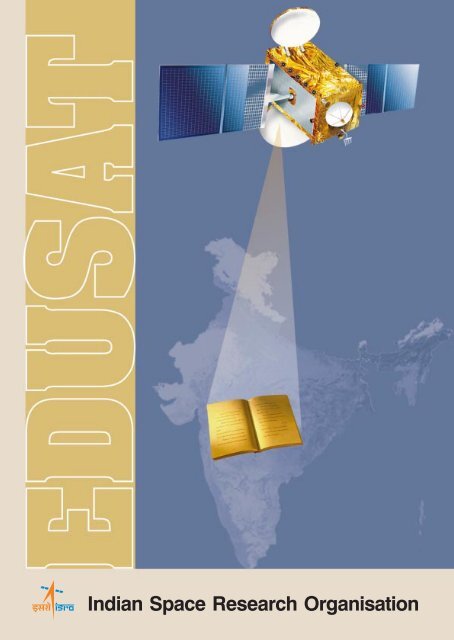
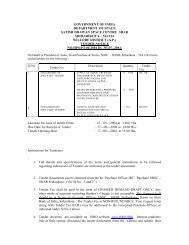
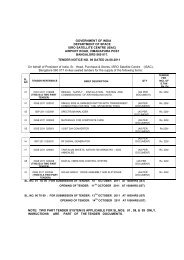

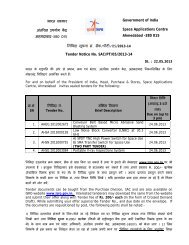

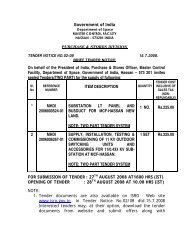
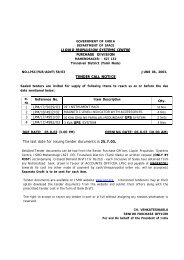

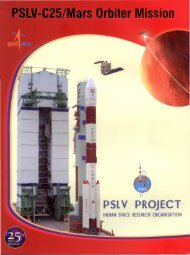
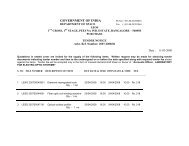
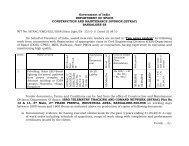
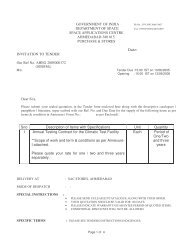


![Government of India Government of India ¢ ] ¢ ] Space ... - ISRO](https://img.yumpu.com/23555817/1/190x245/government-of-india-government-of-india-space-isro.jpg?quality=85)